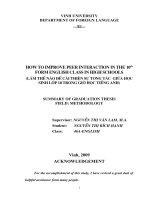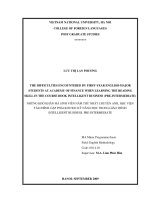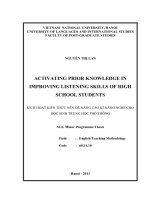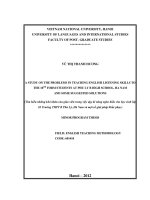SKKN improve english listening skills in high schools
Bạn đang xem bản rút gọn của tài liệu. Xem và tải ngay bản đầy đủ của tài liệu tại đây (68.68 KB, 11 trang )
Improve English listening skills in high schools
A. INTRODUCTION
I-REASONS FOR CHOOSE THEMES:
The goal of English is to form and develop students' basic skills in English and the
intellectual qualities needed to continue studying or entering working life. As a result, new
high school grade high school English textbooks are developed according to the same
programmatic point of view, which is the thematic approach and promotes active learning
methods of students .
All four skills of listening, speaking, reading and writing are concerned and coordinated
in the tasks of class activities.
One of the four skills that English learners in general and high school students in
particular often face certain difficulties in the learning process is listening skills.
In fact, in order to acquire English listening skills, foreign language learners must have a
regular listening practice, long-term with different listening forms and content. Teaching and
learning English is no longer new but difficult for all high school teachers and students.
According to the old textbook program, there is no teaching lesson. The teaching of English
in high school is only included in the program since students follow the curriculum.
The fact shows that listening comprehension skills of Huong Hoa High School students in
general and students in grades 12 and 11 are directly teaching. Students only work on sensory
listening focused on listening and awareness, but not yet listening and understanding
information so that it is effective and flexible.
By studying this topic, I would like to help teachers gradually overcome difficulties to
conduct listening to English lessons more effectively, students are more active and active
when receiving and comprehending. knowledge of the lesson.
II-RESEARCH DUTIES:
When researching this topic, I need to perform the following tasks:
1. Study English teaching and learning materials, listening and teaching techniques.
2. Teaching and teaching.
3. Class observation, exchange and experience.
4. Check and evaluate the results of students' handing, so that there is a thing reasonable
additional correction.
1
III.THE RESEARCH:
The topic revolves around the issue of teaching and learning English of high school
teachers and students in grades 10, 11 and 12 Huong Hoa High School. But the object of
typical research that I boldly applied this topic is the 12A2, 12B6,11A1 students.
IV. OBJECT TO STUDY:
Subjects of the study and survey of this topic mainly focus on the group of students that I
have directly taught as assigned by the school earlier this year. From the beginning of the
school year, I have given the students a quality survey which includes listening skills. I found
the results as follows: Class 12A2 has 39 students, there is 1 good listening student, 5 good
listening students, 10 weak students and 9 students with poor listening skills. Class 12B6 has
36 students, none of them are good at listening, 2 are good, 11 are average, 12 are weak, 11
are poor. In addition, in 11A1 class, there were 44 students with 3 good students, 11 good
students, 16 average students, 8 weak children and 6 poor children. The vast majority of
children have not been able to listen and process information so effectively and accurately.
V. RESEARCH OBJECTIVES:
With the successful study of the topic, this experience initiative will help the teachers
and students get the following experience:
1. How to organize a lesson to teach is effective.
2. Steps to conduct a lesson are effective.
3. Instruct students to practice and train themselves in English listening skills and
techniques
VI. RESEARCH METHODOLOGY:
1. Observation method: I research and study for myself, and attend the class visit time of my
colleagues.
2. Methods of discussion and discussion: After attending colleagues' time, my colleague, my
colleagues and I conduct discussions and discussions to learn from the experience.
3. Experimental method: Teachers conduct teaching according to each purpose, specifically
require some teaching lessons.
4. Methods of investigation: Teachers ask questions to check and assess the content of
students' content.
2
B- CONTENT SECTION
I. THEORY:
1. Purpose of teaching:
The purpose of teaching foreign languages is not to provide students with knowledge of that
language, the ultimate goal of language teaching is to teach students the ability to
communicate in that language. The ability of students to communicate is expressed through
skills: Listening, Speaking, Reading and Writing. Students' listening skills are formed through
one learning process in English language environment. In addition to studying at school,
students must learn and practice listening through different forms and methods. Listening
skills are the ability to use language knowledge for listening purposes in English.
2. The basic factors directly affect the effectiveness of listening lessons.
a- Teachers:
-With new and positive teaching methods, teachers play the role of directing and controlling
students during the lesson.
- In order to conduct an effective lesson, teachers need to perform well the following basic
elements:
+ Choose and flexibly use listening techniques suitable to each lesson content
+ Organizing and controlling classes, allocating reasonable time.
+ Proficiently using facilities and equipment for teaching and learning to serve listening.
+ Create appropriate teaching aids for teaching.
+ Inspire, attract, attract students.
b- Teaching techniques (Listening Techniques)
The method of teaching listening is regulated by the content of listening, in other words, the
content of the lesson is listening to the selection, applying the methods of teaching and
listening. Each teaching technique is suitable with specific forms of teaching (teaching
grammar, teaching speaking, teaching writing)
c. Equipment for teaching and learning for listening:
-The use of equipment to support teaching pictures for foreign languages in general and
English in particular is considered a means of expressing a part of the main content of
textbooks. In all units lesson program new textbook content
The song is recorded in a cassette tape, and the textbook only records listening exercises. In
order to perform well these listening exercises, learners must listen to the contents of the
3
lesson in the tape. Moreover, teaching equipment is also a positive means of innovating
teaching methods, motivating motivation and stimulating learning.
-The equipment needed for the subject:
+ Transceiver cassette tape.
+ Recorder for reading and listening.
+ Painting pictures illustrating lesson content in textbooks.
+ Photos, objects created by teachers ...
+ Application software such as AI, projector, interactive board ..
d. Students:
In the relationship between how to teach and how to learn: Teachers are nests
students, control, students self-mastering knowledge with their own manipulations,
intellectual actions under the role of teachers.
In order for the lesson to be heard well, students need to have the necessary skills in listening
in English.
II-CURRENTLY TEACHING TO LISTEN TO ENGLISH LANGUAGE TRAINING
AT HUONG HOA HIGH SCHOOL.
1. Advantages:
Although there are objective and subjective conditions that directly affect the teaching
process, we have overcome the shortcomings, step by step improve the quality of English
teaching hours to meet purpose, new program.
a. For teachers:
- The first step is to approach relatively good use of specific teaching techniques -listening
techniques.
- Being used and active with the way to organize a lesson to teach listening.
- Flexible coordination of teaching techniques.
- Create a variety of teaching aids suitable to the content of lessons, so many teaching lessons
become lively, charismatic and highly effective.
- Using modern teaching equipment to serve the process well : cassette tapes, phototherapy ...
b. On the students side:
4
-Students familiarize themselves with listening.
-Many students have heard and recognized the voice of native speakers.
-The majority of students have heard simple listening content.
-Some students have formed skills in learning.
2. Exist:
a. Teachers:
- There are still some teachers encountering certain difficulties in performing listening and
teaching techniques, in selecting techniques to suit each lesson period, each stage of teaching
period, and also afraid of using or not proficient in teaching aids for listening lessons
(software, interactive tables, labs)
b. Students:
- The motivation for listening in English is limited.
-Many children have few opportunities to listen, have little access to mass media, and can
listen to English.
-Some of you are afraid to listen and speak in English, afraid to make mistakes.
- Students are not familiar with the speed of reading and speaking in English tapes.
c. Convenient teaching aids:
- Teaching aids for teaching are too few: pictures, radio ...
- Quality tape is not good.
d. Specific investigation:
-In the teaching process, I myself took the 12th grade
save the characteristics of the students' learning situation while taking lessons. From the
beginning of the school year I have guided myself to a specific plan and method
proactively investigating the learning situation of students who directly teach. Through the
investigation, I realized that most of the students have a poor vocabulary, listening and
communication skills
English reception is limited. The survey results are as follows:
Grade
Total
Gifted
amount
12A2
39
1
good
rate
2,56
amount
5
Average
rate
amount
12,8%
10
5
weak
rate
25,6
amount
14
poor
rate
35,8
amount
9
rate
23
%
%
%
%
12B6
36
0
0%
2
5,6%
11
28,2
%
12
31,7
%
11
28,
8%
11A1
44
3
6,8%
11
25%
16
41%
8
18,1
%
6
13,
6%
III. SOME ACTUAL SOLUTIONS TO PROGRESS A HEALTHY HEARING
1. Plan a lesson to hear:
a. For teachers:
In order for a lesson to be heard well, the teacher should take the following steps:
-Studying the contents of lessons taught from textbooks, teacher books because textbooks,
book of teacher are an important basis for teaching teachers to teach lessons. The careful
study of textbooks and book of teacher will help teachers organize and control teaching
lessons mind, focus, time distribution for steps, activities in a scientific way.
- Study the purpose of the lesson: Purpose, requirement of lesson is the goal that teachers and
students need to achieve after each lesson. For listening lesson,
Usually the purpose of the lesson is to help students practice and develop skills: Listening
Speaking, Reading and Writing (in which listening skills are mainly). After finishing listening
to the students understand the main content of the listening and perform some language
requirements or exercises.
-Choose and coordinate listening techniques in a flexible and appropriate way (based on the
content of teaching, score, capacity of the class and stages in the listening process: Prelistening, while listening, listening. In each stage, there are specific listening techniques.
-Good use of teaching facilities and equipment for listening lesson:
* Using clay sand machine:
+ Before performing the teaching, it is necessary to prepare the machine well, clear tape and
spare battery prevent power failure.
+ Must ensure safety when operating
+ Considering the necessity, effectiveness, specific time for each stage ...
* Using illustrations:
+ Channel in textbook: One of the strengths of the textbook compiled under the new program
is that there are many illustrations. Utilization to the extent maximizing the pictures in the
textbooks and the Internet to help students understand the lesson is important.
6
+ The illustration must have a close relationship with the content of learning.
+ Need a reasonable and scientific lesson: Teachers need to plan clearly activity, game
activity, requirements of each exercise, payment options suits to students' words
+ Discuss discussion about teaching plans with colleagues.
b. With students:
The teacher asks students to be well prepared for the next lesson by:
-A system of fat questions about lessons that you are about to learn for students to have time
to think, learn materials.
- Ask students to do some exercises related to the lesson content.
- Encouraging and motivating students to be confident, proactive and creative to raise
questions
related to the lesson.
2. Good implementation of listening process
The process of a listening lesson includes three stages: Pre-Listening, While-Listening, and
Post-Listening. This process not only helps students understand the lesson but also helps them
use listening skills in real communication. But the prerequisite is that teachers need to clearly
identify the purpose of each specific listening lesson so that they can guide students to
perform well in the next stages.
a. Pre-Listening:
(True / False Prediction, Open Prediction, Ordering, Pre-Questions)
This is the stage to help students navigate, think about the topic or situation before the
students hear. This period:
-The teacher should create a sense of preparation for the students by asking questions about
the subject, asking the students to observe the picture, read the words and guess what topics
they will listen to, who is going to tell who ...
-The teacher can ask students to work in groups to predict the content about to hear through
pictures or listening situations. Maybe they say incorrectly to what they are about to hear but
the problem is that they are interested before listening.
- Teachers help children anticipate difficulties that may be encountered in new pronunciation
or structure, background knowledge.
-Finally, the teacher will tell the students how many times they will hear and guide the task
request when listening (choose right, wrong, answer questions ...)
7
b. While-Listening:
(Selecting, Deliberate Mistakes, Grids, Listen and Draw, Comprehension Questions)
This is the period when students have the opportunity to practice. At this stage, the teacher
sets out the types of exercises, asking students to do it. Students may make mistakes at this
stage so teachers need to correct students' mistakes and make correct choices.
Teachers turn on the tape or read 2 to 3 times (if the content is difficult to do more times. First
help students with listening comprehension and listening content (pen down). Second time
listening to the main information to complete The third time you listen to and review the
exercise, the main goal of listening is to understand that students listen to the main content or
detailed information and understand the attitude of the author. The teacher lets the students
listen to the whole lesson to get a general idea as well as a lesson layout and homework, and
then listen to each paragraph to get the result or listen to the hard places to confirm the
answer. restricting students from hearing every word because doing so will make learners
have a habit of understanding each word before listening.
c. Post-Listening:
( Role -play, Recall the story, Write-it-up, Further practice ...)
This is the practice stage after listening. At this stage students use knowledge and language
skills that have been practiced at the stage of "While - Listening" in meaningful, practical
communication situations. After listening, students need to do some exercises such as: report
to the class or group about the results of the exercises, other students listen, give feedback, or
treat the lesson for you. Teachers need to combine other skills such as recall, write-it-up,
discussion ...
IV.THE RESULTS REACHED AFTER THE APPLICATION
Applying this experience initiative myself has achieved some positive results. First of all,
these experiences are very relevant to the program, new textbooks; students are more
interested in learning, actively and creatively to expand their knowledge, and are also very
flexible in acquiring knowledge and developing skills. The learning atmosphere boiled gently.
Students have the opportunity to assert themselves, no longer confused when entering the
lesson. These are also the reasons for the relatively satisfactory results of the first term:
Grade
Total
Gifted
amount
12A2
12B6
39
36
5
2
Good
rate
12,8%
5,5 %
amount
10
8
Average
rate
amount
25,6
%
15
22,2
%
20
Weak
rate
38,4
amount
6
%
8
55,5 %
4
Poor
rate
amount
rate
15,3
%
3
7,6
11,1
%
2
%
5,5
%
11A1
44
8
18,8
%
19
43,1
%
12
27,2 %
4
10,2
%
1
2,5
6%
V. LEARNING EXPERIENCE
After successfully applying this topic I myself have achieved significant results and valuable
experiences for the coal version as follows:
1.-Teachers must always create a foreign language environment during school hours and must
use English as the main language for communication. Depending on the grade and the
student, the teacher can use short, simple, understandable, easy-to-remember English
sentences.
-The teacher must always encourage students to use English in communicating with the
learned knowledge.
-The teacher should not pay too much attention to the student's error while speaking. Let the
children listen and speak naturally. Never forced students to stop talking while the student
was trying to express his thoughts in English; Doing so will make you feel afraid when
listening and speaking.
- Teachers should integrate English listening and speaking activities in the form of "playing
and learning."
-Instruct the children to practice listening to English via radio, television ...
2. Teachers need to be attractive, attract students by means of activities, appropriate listening
and teaching techniques for each stage of a listening lesson.
3. Use listening aids suitable to the content of the lesson like pictures, models. Use tapes,
discs, projectors, interactive whiteboards and creative software (record an English audio track
on tapes or discs 3 to 4 times. This is very convenient to manipulate and save time in class. ).
4. At the practice stage after listening, teachers need to provide appropriate exercises, with
high practical communication features.
VI.THE RECOMMENDATIONS:
Derived from the theoretical, practical and teaching purposes as well as the successes and
limitations when implementing the topic, to contribute to teaching English in general, to teach
listening in particular to achieve better quality. than I have the following practical
recommendations:
* On the basis of:
9
-The language learning skills must be practiced according to specific characteristics in the
foreign language environment, so there should be a department room to avoid making noise
for the nearby classes as well as not being affected by the noise from outside to.
-Electric system must be cultivated to ensure usefulness and safety when using.
-Provide more cassettes, cassette tapes (less radio stations, tapes and discs, the quality is not
guaranteed.)
* On the top leaders:
Need to create conditions for teachers to have opportunities to exchange, learn and learn
experiences through seminars.
C- CONCLUSION
At high school, listening to English in the program is a good condition for students to develop
a full range of language skills. But the teaching and learning of English is "new" for both
students and teachers. Both students and teachers are unavoidable. With this experience, I
hope to make a small contribution to helping our teachers and students overcome the
difficulties to implement teaching and learning English for better results. On my own side, I
promise to continue to inherit and promote the results achieved by the implementation of the
topic and at the same time constantly learn from experience, overcome difficulties in teaching
to meet request to renew the curriculum, teaching methods of the Ministry of Education and
Training.
Huong Hoa, May 15, 2019.
Implementer
Vo Ngoc Son
10
REFERENCES
1. Book of teachers and new textbooks of the Ministry of Education and Training.
2.Book "Some issues on innovation of high school teaching methods in English of the
Ministry of Education and Training
3. Training materials to renovate English subjects
4.English language Teaching Methodology of Ministry of Education and Training 2003.
5. Evaluation in Education of the Ministry of Education and Training.
6. “ English Now” of the British Council
11









